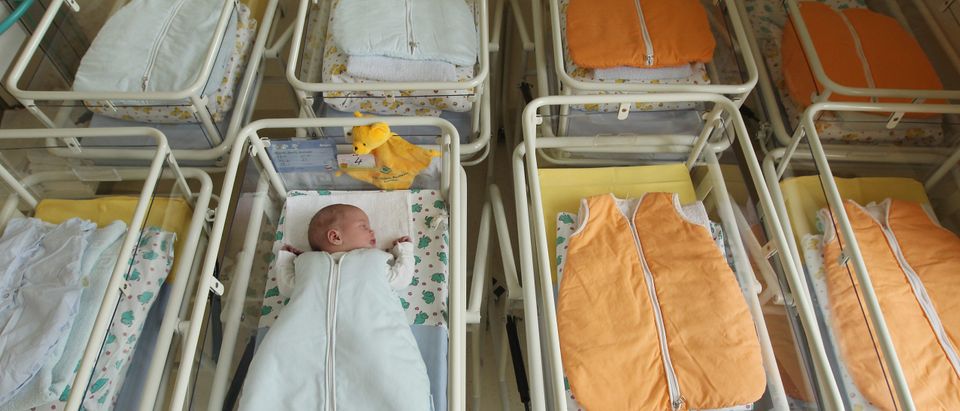- An “avalanche” of “expanding and accelerating” demographic forces is driving birth rates down, demographers warned The New York Times.
- The publication described ghost cities in northeastern China, South Korean universities scrambling for students, hundreds of thousands of razed properties in Germany and shut down maternity wards in Italy.
- Demographers predicted to the Times that by the second half of the century — or earlier — the global population will enter a sustained decline.
- “A paradigm shift is necessary,” German demographer Frank Swiacznyn told the Times. “Countries need to learn to live with and adapt to decline.”
An “avalanche” of “expanding and accelerating” demographic forces is driving global birth rates down at alarming rates, demographers warned The New York Times.
“A paradigm shift is necessary,” German demographer Frank Swiaczny, former United Nations chief of population trends and analysis, told the Times. “Countries need to learn to live with and adapt to decline.”
The publication described ghost cities in northeastern China, South Korean universities scrambling for students, hundreds of thousands of demolished properties in Germany, and shut down maternity wards in Italy, and warned that countries like Hungary, China, Sweden and Japan are already pushing to balance the combination of “swelling” older populations with the needs of young people.
Professor Brad Wilcox, director of the National Marriage Project, called the report “jaw-dropping.” (RELATED: Pope Francis Decries Plunging Birth Rates: ‘No Future’ Without The Family)
“From South Korea to South America, from Italy to the U.S., we’re witnessing an epochal fall in fertility,” the professor warned.
A host of factors, which the Times described as “an avalanche” of “demographic forces,” appear to be accelerating toward more deaths than births almost globally, except in Africa.
Demographers predicted to the Times that by the second half of the century — or earlier — the global population will enter a sustained decline.
Jawdropping NYT story:
From South Korea to South America, from Italy to the U.S., we’re witnessing an epochal fall in fertility: “Like an avalanche, the demographic forces — pushing toward more deaths than births — seem to be expanding & accelerating.”????????https://t.co/vUVqk6pntp pic.twitter.com/RhURNfGStb
— Brad Wilcox (@WilcoxNMP) May 23, 2021
U.S. fertility rates are at their lowest since the government began tracking such data in the 1930s, according to data from the Centers for Disease Control and Prevention’s National Center for Health Statistics released in early May. Census announcements from China also showed slowest birth rates in decades, the Times reported, noting that “the era of high fertility is ending.”
More parents are delaying getting pregnant and fewer babies are being born, in part due to gains in contraception and education for women, the Times reported. Economic anxieties have also contributed to lowering birth rates, experts have said.
“It’s not just COVID,” University of New Hampshire senior demographer Kenneth Johnson previously told the Wall Street Journal. “It’s the fact that the birthrates never recovered from the Great Recession.”
“I’ve been waiting for years to see a big jump in fertility to women in their 30s and it hasn’t happened,” Johnson said.
The Times reported that though the change in birth rates may take decades, the decline will spiral exponentially once it starts.
Asian demographer Stuart Gietal Basten described the process to the Times as a “cyclical mechanism,” adding, “It’s demographic momentum.”
“Maternity wards are already shutting down in Italy. Ghost cities are appearing in northeastern China. Universities in South Korea can’t find enough students, in Germany, hundreds of thousands of properties have been razed, with land turned into parks.” https://t.co/vUVqk6pntp
— Brad Wilcox (@WilcoxNMP) May 23, 2021
A few countries’ immigration policies have softened the impact of the “demographic time bomb” through immigration, but migration out of certain regions in Eastern Europe and huge parts of Asia have not fared so well. (RELATED: Chinese Birth Rate Hits 60-Year Low As Population Growth Slows)
South Korea’s fertility rate dropped to the lowest in the developed world in 2019, according to the Times: 0.92, which is less than one child per woman. The country’s fertility rate has continued to drop for the past 59 months, the publication reported.
This declining birth rate has created a two-tiered society in which major cities continue to grow but regional towns waste away without children.
In the Italian town of Capracotta, the population has “dramatically aged and contracted” from 5,000 people to 800, according to the Times. One former school has been converted to a nursing home.
“There were so many families, so many children,” said 93-year-old former student and teacher Concetta D’Andrea. “Now there is no one.”
In Agnone, about a half an hour away from Capracotta, the town’s maternity ward was forced to close due to fewer than 500 births a year, according to the Times. Six babies were born in the town this year, the publication reported.
“Once you could hear the babies in the nursery cry, and it was like music,” nurse Enrica Sciullo, who formerly cared for babies and now tends to the elderly, told the Times. “Now there is silence and a feeling of emptiness.”
All content created by the Daily Caller News Foundation, an independent and nonpartisan newswire service, is available without charge to any legitimate news publisher that can provide a large audience. All republished articles must include our logo, our reporter’s byline and their DCNF affiliation. For any questions about our guidelines or partnering with us, please contact licensing@dailycallernewsfoundation.org.












